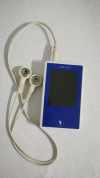Ameliorating Effects of Transcutaneous Electrical Acustimulation Combined With Deep Breathing Training on Refractory Gastroesophageal Reflux Disease Mediated via the Autonomic Pathway
- PMID: 31347247
- PMCID: PMC6771489
- DOI: 10.1111/ner.13021
Ameliorating Effects of Transcutaneous Electrical Acustimulation Combined With Deep Breathing Training on Refractory Gastroesophageal Reflux Disease Mediated via the Autonomic Pathway
Abstract
Aims: To investigate the effects and possible mechanisms of transcutaneous electrical acustimulation (TEA) combined with deep breathing training (DBT) on refractory gastroesophageal reflux disease (rGERD).
Methods: Twenty-one patients with rGERD were recruited and randomly assigned to receive either only esomeprazole (ESO, 20 mg bid) (group A, n = 7), TEA + DBT + ESO (group B, n = 7), or sham-TEA + DBT + ESO (group C, n = 7) in a four-week study. The reflux diagnostic questionnaire (RDQ) score and heart rate variability (HRV) were recorded and evaluated at baseline and at the end of each treatment. Blood samples were collected for the measurement of serum acetylcholine (Ach) and nitric oxide (NO). Esophageal manometry and 24-hour pH monitoring were performed before and after the treatment.
Results: After treatment, 1) the participants in group B had significantly lower scores of RDQ and DeMeester and increased lower esophageal sphincter pressure (LESP) than those in group C (all p < 0.05), suggesting the role of TEA; 2) low frequency band (LF)/(LF + HF) ratio in groups B and C was decreased, compared with group A (p = 0.010, p = 0.042, respectively); high frequency band (HF)/(LF + HF) ratio in B and C groups was significantly increased, compared with group A (p = 0.010, p = 0.042, respectively); 3) The serum Ach in groups B and C was significantly higher than group A (p = 0.022, p = 0.046, respectively); the serum NO in groups B and C was significantly lower than group A (p = 0.010, p = 0.027, respectively).
Conclusions: TEA combined with the DBT can effectively improve the reflux symptoms in rGERD patients by increasing LESP and reducing gastroesophageal reflux, which may be mediated via the autonomic and enteric mechanisms.
Keywords: Deep breathing training; gastroesophageal reflux; heart rate variability; low esophageal sphincter pressure; transcutaneous electrical acustimulation.
© 2019 The Authors. Neuromodulation: Technology at the Neural Interface published by Wiley Periodicals, Inc. on behalf of International Neuromodulation Society.
Figures






Similar articles
-
Elevation of Lower Esophageal Sphincter Pressure With Acute Transcutaneous Electrical Acustimulation Synchronized With Inspiration.Neuromodulation. 2019 Jul;22(5):586-592. doi: 10.1111/ner.12967. Epub 2019 May 28. Neuromodulation. 2019. PMID: 31136053 Clinical Trial.
-
Integrative Effects and Vagal Mechanisms of Transcutaneous Electrical Acustimulation on Gastroesophageal Motility in Patients With Gastroesophageal Reflux Disease.Am J Gastroenterol. 2021 Jul 1;116(7):1495-1505. doi: 10.14309/ajg.0000000000001203. Am J Gastroenterol. 2021. PMID: 34183577 Clinical Trial.
-
Effects of Transcutaneous Electrical Acustimulation on Refractory Gastroesophageal Reflux Disease.Evid Based Complement Alternat Med. 2016;2016:8246171. doi: 10.1155/2016/8246171. Epub 2016 Aug 28. Evid Based Complement Alternat Med. 2016. PMID: 27648103 Free PMC article.
-
The effect of breathing exercises on patients with GERD: a meta-analysis.Ann Palliat Med. 2020 Mar;9(2):405-413. doi: 10.21037/apm.2020.02.35. Epub 2020 Mar 17. Ann Palliat Med. 2020. PMID: 32233626 Review.
-
Electrical devices for functional visceral pain.Neurogastroenterol Motil. 2023 Mar;35(3):e14518. doi: 10.1111/nmo.14518. Epub 2022 Dec 15. Neurogastroenterol Motil. 2023. PMID: 36520617 Review.
Cited by
-
Neuromodulation for functional upper gastrointestinal diseases.Gut Microbiota Integr Wellness. 2023;1:10.54844/gmiw.2022.0087. doi: 10.54844/gmiw.2022.0087. Epub 2023 Apr 28. Gut Microbiota Integr Wellness. 2023. PMID: 38406297 Free PMC article.
-
Neuromodulation and the Gut-Brain Axis: Therapeutic Mechanisms and Implications for Gastrointestinal and Neurological Disorders.Pathophysiology. 2024 May 17;31(2):244-268. doi: 10.3390/pathophysiology31020019. Pathophysiology. 2024. PMID: 38804299 Free PMC article. Review.
-
Efficacy of abdominal breathing on sleep and quality of life among patients with non-erosive gastroesophageal reflux.J Public Health Res. 2024 Feb 17;13(1):22799036241231788. doi: 10.1177/22799036241231788. eCollection 2024 Jan. J Public Health Res. 2024. PMID: 38370147 Free PMC article.
-
Electroceuticals and Magnetoceuticals in Gastroenterology.Biomolecules. 2024 Jun 26;14(7):760. doi: 10.3390/biom14070760. Biomolecules. 2024. PMID: 39062474 Free PMC article. Review.
-
Exacerbation of symptoms, nocturnal acid reflux, and impaired autonomic function are associated with sleep disturbance in gastroesophageal reflux disease patients.Front Med (Lausanne). 2024 Aug 21;11:1438698. doi: 10.3389/fmed.2024.1438698. eCollection 2024. Front Med (Lausanne). 2024. PMID: 39234038 Free PMC article.
References
-
- Philip OK, Lauren BG, Marcelo FV. Guidelines for the diagnosis and management of gastroesophageal reflux disease. Am J Gastroenterol 2013;108:308–328. - PubMed
-
- Roman S, Mion F. Refractory GERD, beyond proton pump inhibitors. Curr Opin Pharmacol 2018;43:99–103. - PubMed
-
- Jensen RT. Consequences of long‐term proton pump blockade: insights from studies of patients with gastrinomas. Basic Clin Pharmacol Toxicol 2006;98:4–19. - PubMed
Publication types
MeSH terms
Grants and funding
LinkOut - more resources
Full Text Sources
Medical
Research Materials
Miscellaneous

